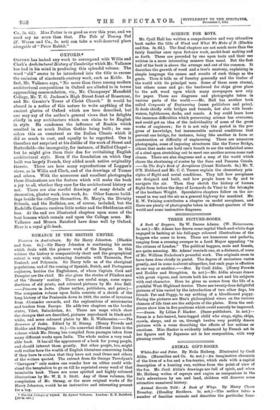SCIENCE FOR ROYS.
Mr. Cyril Hall has written a comprehensive and very attractive book under the title of Wood and What We Make of It (Mackie and Son. 3s. (3d.). The final chapters are not much more than the fairly familiar ones upon fret-saw work, model-boat making and so forth. These are preceded by one upon tools and their use written in a more interesting manner than usual. But the first half of the book is above the average and out of the common. It describes the growth of wood and a tree's anatomy, explaining in simple language the causes and results of such things as the grain. Then it tells us of forestry generally and the timber of the world with its principal uses. Some of these seem eternal, but others come and go: the hardwood for ships gives place to the soft wood upon which many newspapers now rely for paper. There are diagrams and photographs taken in various parts of the world.—Mr. Hall has another book called Conquests of Engineering (same publishers and price). It deals chiefly with bridges and tunnels, but also with break- waters, lighthouses, docks, and canals. A boy could learn here the immense difficulties which persevering science has overcome, and could get an idea of the individuality of some of the great works of engineers ; for it is not only the period in the pro- gress of knowledge, but innumerable natural conditions that prevent one bridge, for instance, being like another in form or construction or difficulty of engineering. There are numerous photographs, some of imposing structures like the Tower Bridge, others that make one hold one's breath to see the unfinished arms of a steel span stretching out to meet one another across some vast chasm. There are also diagrams and a map of the world which shows the shortening of routes by the Suez and Panama Canals. —In The Boy's Book of Aeroplanes (Grant Richards. 6a.) Mr. T. O'B. Hubbard and Mr. C. C. Turner explain the elementary prin ciples of flight and aerial conditions. They tell how aeroplanes are designed and built, and how people learn to fly and to navigate the air. Then they sketch the history of human flight from before the days of Leonardo da Vinci to the triumphs of the brothers Wright. Speculative chapters follow on the air- vessel in war and the air as a general highway for mankind. Mr. E. W. Twining contributes a chapter on model aeroplanes, and there are plenty of photographs taken in different quarters of the world and some instructive diagrams.






































































 Previous page
Previous page